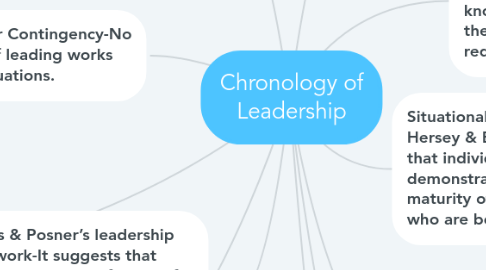Chronology of Leadership
af Edith Gyan


1. Exchange theory- it stresses the interaction of the leader with the subordinate.
1.1. Contingency model by Fielder-proposes that the performance of any group depends on the style of the leader, motivation, and relationship to the subordinates and favorability of the situation.
1.2. Psychoanalytic theory by Erikson- a leader’s awareness of his or her predisposition to lead or follow is crucial in self diagnosis and application.
1.2.1. House’s Path goal theory- The theory illiterates that a leader can affect subordinates performance, satisfaction, and motivation in three ways. By rewarding achieved performance goals, clarifying paths towards the goals, & removing obstacles to performance.
2. Normative Decision-making by Vroom, Yetton, & Jago - helps leaders make more effective decisions whiles garnishing support from the subordinates.
2.1. Leader member exchange & Vertical Dyad linkage theories by Graen- The model is of the view that leaders accomplish work through various personal relationships with different members of the subordinate group.
3. Managerial & Strategic leadership by Buckingham & Clifton-It suggests that leadership is a process of focusing on follower strengths rather than trying to eliminate weakness.
4. Kouzes & Posner’s leadership framework-It suggests that leadership is successful only if a shared vision can be communicated to followers that changes their values and results in a goal directed behavior and positive work related outcomes.
5. Situational or Contingency-No single way of leading works well in all situations.
6. The army leadership model- It emphasizes character, knowledge, and application known as be- know- do. It is of the view that leadership requires experience.
7. Bennis’s competency based leadership- The model suggests that the skills and tools necessary to lead an organization must be learned.
8. Situational leadership theory by Hersey & Blanchard- it suggests that individual leadership style demonstrated should match the maturity of the subordinates who are being led.
8.1. Charismatic leadership by House- the model is of the view that charismatic leadership inspires followership through intangibles which cannot be measured directly.
8.1.1. Transformational leadership by Burn- This model is of the view that situation influences the leader to adapt a style most fitting to to a circumstance at hand.
9. The Boundaryless leader- The suggests that innovation and metrics, not opinion and preference drive change. Also, if employers want improved performance, they should challenge their employees to create and adhere to short term goals.
10. Theory X & Y by McGregor- The X theory are of the view that people are lazy, extrinsically motivated, incapable of self discipline, and want security and no responsibility. Theory Y people do not inherently dislike work. They intrinsically motivated, exert self control, and seek responsibility.
10.1. Stogdill & Coons Ohio leadership studies
10.1.1. University of Michigan leadership studies
10.2. Skill theory by Katz
10.2.1. Personality & Organizational theory by Argyris
10.3. Behavioral leadership phase - The notion is that leaders could be learned or thought.
11. Great Man Leadership Phase_The theory assumes that specific traits make a person an effective leader. It focuses on leaders who are great.
11.1. Trait theory by Lewin, Lippitt, & Whites
11.2. An early leader theory by Xenophon
11.2.1. Narcissist theory by Machiavelli

